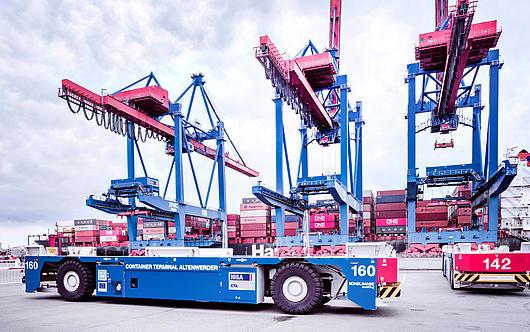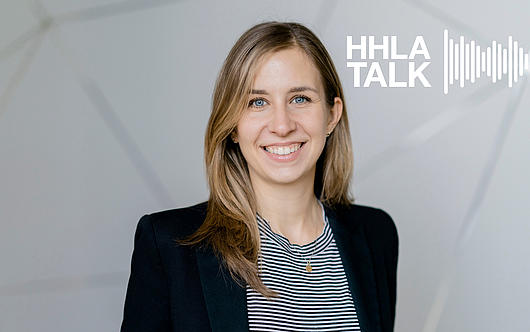
HHLA’s rail subsidiary Metrans is a pioneer in the world of sustainable logistics. Over 95 percent of its rail traffic is already certified carbon-neutral* and the company is implementing a whole host of other ideas at its terminals. We asked Robert Groiss from Metrans which measures are particularly effective and what the EU can do to increase the volume of goods transported by rail.
Welcome to HHLA Talk, Robert! You are responsible for sustainability at Metrans, but not just that. What other tasks fall under your remit?
I’ve been at Metrans for five and a half years now and I’m responsible for the major topic of sustainability and also for business development. I’m also responsible for funding topics, maintaining contact with various associations and with the European Commission. There are a whole range of legislative developments and innovations in intermodal transport that need to be monitored. On top of that is the expansion of the terminals, particularly in Austria, because I live in Vienna.
That’s a lot of interesting topics there – let’s start with your sustainability campaign.
Right from the start, I was fascinated by the fact that Metrans not only talks the talk but walks the walk when it comes to sustainability. It was a joint initiative with HHLA that got things off the ground: the “Balanced Logistics” strategy. The strategy had a clear aim: to become climate-neutral* by 2040.
We worked together and the result was the product HHLA Pure. The willingness of the Metrans Executive Board to take action in terms of making transportation more sustainable was something I found impressive. My whole working life has been spent in the logistics and transport sector. Of course, we know that transportation results in high emissions. But at Metrans, a project was launched and implemented immediately. Now we really are more sustainable and this makes us stand out from the competition.
Overall, the logistics industry has a huge carbon footprint. Can you describe a bit more specifically where emissions are produced and what is being done to reduce them?
We primarily work in the intermodal sector and the longest distances are covered with electric locomotives. This means we are producing less CO2 and in countries such as Germany and Austria, we are increasingly powering our vehicles with green electricity. The last mile is still driven with diesel-powered heavy goods vehicles and conventional reach stackers are still in use at the terminals. Butcompared to road transport, according to various experts rail transport cuts emissions by 60 to 70 percent. This was the inspiration behind expanding our HHLA Pure product.


Do the Metrans terminals look similar to the HHLA terminals in this respect? With everything electrified and with most of the equipment running on electricity from renewables?
Yes, we are trying to install electric cranes everywhere. Diesel-powered reachstackers cannot yet be replaced, but we are of course looking at how they can be powered by renewable energies in the future. There are already prototypes of such electrically or hydrogen-powered reachstackers, but market developments will have to show which development will be successful.
You also have another special concept that means containers no longer have to be driven about the terminal at all. A yard right below the rail gantry crane …
That’s right. We stack up to three containers right below the jibs of the rail gantry cranes, acting as a kind of temporary storage yard. This means a significant amount of volume no longer has to be transported around the terminal. The container comes directly off the train, is stored next to the rails and the crane lifts it and loads it straight onto the outgoing heavy goods vehicle. Then we don’t need the reach stackers and everything is powered by electricity.
We have a total of 28 cranes. Last year, we specifically expanded major terminals such as Dunajska Streda, Ceska Trebova and Budapest from three to four cranes. Our biggest terminal in Prague now has six of these cranes in operation. It’s a major development, but not the only one. For example, the terminal lighting systems, which were using conventional bulbs, were fitted for LEDs. Office buildings are now constructed using more environmentally friendly methods and electricity is generated using photovoltaic systems.
I’ve also seen the first electric-powered truck in Hungary, used for the last mile!
We believe in electric-powered vehicles, even if there are a few promising hydrogen projects. We are testing this in Budapest. For example, we have established a panel of experts to analyse and discuss the topic of electric trucks. Our aim is to switch over our fleets to electric-powered vehicles in the future, starting at the major terminals. After all, the last mile also needs to become carbon-neutral.

Where is there still scope for making rail transport even greener?
We try to purchase the most environmentally friendly electric locomotives around, with the lowest energy consumption. In the past, shunting at the terminal was always done by diesel-powered locomotive. Today, we have several hybrid locomotives in service, powered by both diesel and electricity, i.e. battery-powered. This enables us to further reduce emissions.
A long while back now, we developed wagons that are lighter than the conventional ones used for transporting containers. Overall, they weigh four tonnes less and are more flexible in terms of loading. This means that we can operate longer trains with the same energy consumption. Unfortunately, there are still stretches of track that have not yet been electrified, particularly in Central Europe. In those areas, we will try to use hybrid locomotives in future.
Can you say which projects are particularly close to your heart?
It’s got to be HHLA Pure. When we undertook the initial tests in 2018 and 2019, we worked in the same way as most other rail operators. We only offset emissions if the customer specifically requested it. Customers tended to be a little reticent to do so, but the carriers started demanding more sustainable options.
For this reason, we took the plunge in 2020/2021 and transported all containers with certified zero carbon emissions* from Hamburg, Bremerhaven and Koper into the hinterland to all destinations and vice versa. Of the 1.4 million TEU transported by Metrans, this corresponded to nearly 1 million. We invited customers to get on board from the beginning.

So, there were some initial problems?
It wasn’t easy, but there is a lot of pressure from carriers. Sustainability is a huge issue. So we decided to expand our list of destinations for HHLA Pure in September 2023. We have now added Wilhelmshaven, Rotterdam, Gdansk, Rijeka and Trieste, along with Duisburg as a major inland terminal and our new Indija terminal in Serbia. This means that over 95 percent of all Metrans transports are now carbon-neutral. The feedback from our clients, particularly those who already use HHLA Pure, has been very positive. I think we can make a major contribution towards sustainability here, and we are doing it voluntarily.
Over 95 percent of all Metrans transports are now carbon-neutral*.
You spoke about the pressure coming from forwarders. What does that look like?
It’s primarily our clients, so shipping companies and freight forwarders, who feel the pressure from carriers. With HHLA Pure, you also receive a certificate. This is very popular with customers.
Because not all routes are fully electrified, what will happen with the rest?
First of all, our lightweight wagons, energy-efficient electric locomotives and the very high capacity utilisation of our trains mean that we have very low specific emissions in comparison. The remaining CO2 share in our transport operations is around 10 to 20 per cent compared to pure truck transport. The remaining emissions are offset by gold standard climate protection projects. In the HHLA Pure project, we worked with TÜV to calculate the CO2 emissions per TEU for the 200 or so routes we serve here. These are adjusted annually during the audit by TÜV NORD. In this way, there are clear values relating to how much CO2 can be saved and offset per route.

In other areas, what’s necessary doesn’t seem to have been achieved yet. I’m thinking of the lack of a consistent regulatory framework and financial support from the EU.
We have a lot to do at the moment, based on the EU’s Greening Freight Package. The first draft was published in summer this year. We don’t like everything that’s in the draft because various things could have a negative impact on the development of the intermodal sector. We need to be very active with our associations here so that the drafts will actually permit intermodal transport to account for a greater share.
The rail operators need more scope for development, particularly the private rail companies. Yes, there’s a lot to do at the moment to ensure that legal regulations which facilitate the growth of rail transport and intermodal transport are developed in the next few years.
In terms of the EU, there are various other laws intended to make transport logistics greener. Do you think these are all pointing in the right direction?
The ideas are fundamentally sound, but they are not perfect. Of course, every carrier has its own lobby organisation, or organisations. Some of them are trying to transport higher tonnage on the roads, which has only been possible for intermodal transport until now. Does that make sense?
Rail transport has a lot of issues with European harmonisation. There are projects in the pipeline but the overall European aims are very ambitious. Intermodal transport could play a much bigger role in protecting the environment. The relevant computational models are being developed but we need much more than just bright ideas!
If you could be granted one wish, what should happen to make European transportation more sustainable?
My main wish would be for better rail infrastructure, more investment in this essential mode of transport. We can see that there are not enough tracks available. We need those in order to facilitate the further growth of our rail system.
* The calculation of the carbon footprint takes into account emissions from stationary and mobile combustion (natural gas, diesel), from imported electricity, emissions from commuter traffic and upstream chains of the energy sources used. The carbon footprint verified by TÜV NORD CERT GmbH according to DIN ISO 14064-3:2020 was offset by Gold Standard compensation projects in accordance with TN-CC 020 Standard.


